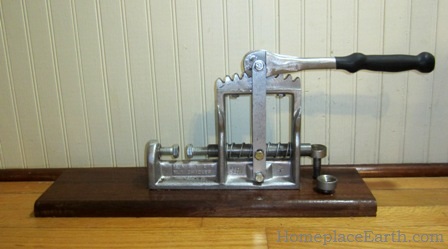We have a couple of black walnut trees near our driveway. Until 2008 I had only paid passing attention to them, never taking the time to harvest the nuts at the right time. To do that, every day or two I would have to pick up the green balls that fell from the trees and throw them in the driveway. Driving over them would remove the green husks. Then I would gather the nuts to air-dry and store for later. If they weren’t gathered from the ground in a timely manner, I would find worms in them. Shelling them was a challenge. I tried cracking them using a hammer and by squeezing them in a vice. Both methods were unsatisfactory. You can find information about these methods and more at http://www.nemahaweb.com/blackwalnuts/crackers.htm. Black walnuts are much harder than the English walnuts you would find in the grocery store and regular nutcrackers won’t work for them. Finally I called my friend Margaret to borrow her black walnut cracker.
Margaret and Jerry moved to their 50 acre farm in late 1982. They had black walnut trees in the yard and intended to make use of them. When Margaret told me of her search for a suitable nutcracker, I told her of an article I had recently read in the December 1983 issue of Organic Gardening magazine. I located that issue on my bookshelf while preparing to write this post. It still contained a note to Xerox the article for Margaret. (Back then we didn’t copy things, we Xeroxed them.) The article profiled four nutcrackers suitable for hard-shelled nuts—hickories, butternuts, and black walnuts. The Potter nutcracker was one of them, and the one owned by the authors, Mike and Nancy Bubel. At the time, I had also checked my copy of Home Food Systems which listed the Potter as the “largest, heaviest, most powerful nutcracker we tested.” Home Food Systems was published in 1981. Margaret bought one and has used it all these years.
Our black walnut trees seem to bear every other year, so I didn’t throw myself into thinking about black walnuts again until the fall of 2010. The Resilient Gardener by Carol Deppe was hot off the press and the green balls were, once again, raining down. Deppe talks about gathering nuts in her book, specifically the need to get them off the ground promptly. I borrowed Margaret’s Potter nutcracker again. However, the best way to store nuts is in the shell, with the cracking done as needed. It became clear that I should have my own tool. With the harvest skipping a year, there were no new nuts to crack in 2011, but I still had some left from 2010 to play with. I had my eye out for a used Potter, since they aren’t manufactured anymore. What I found is the Master Nut Cracker, similar to the Potter.
My husband gave me a Master Nut Cracker for Christmas last year. It is the one in the top photo and it came with a bag of black walnuts. It was just what I needed for my black walnuts—and as I found later—for the hazelnuts (filberts) and peanuts. My husband had also given me small vice grips to use for the hazelnuts, an improvement over my other methods. I thought my hazelnuts would be too small for the Master Nut Cracker, but I found that it cracked all but the very smallest. Eventually I realized that I could shell peanuts with it, also.
This nut cracker lives up to its expectations for cracking black walnuts. If you see advertisements for nutcrackers, read them carefully. If they list walnuts (rather than black walnuts), they mean English walnuts, which are easier to shell. One of the great things about this nutcracker is that it has a second set of anvils. You can see these in the picture. They’re inserted into their storage holes to the right on the board. Just unscrew the larger anvils and put these in and you’re all set to crack smaller nuts. These smaller anvils are what I put on for the hazelnuts. The anvils are concave, allowing you to crack the shells without smashing everything together, which is what happens using the hammer method.
If you are thinking of getting a Master Nut Cracker, be on the watch for the Duke Nutcracker. The Duke is a Chinese knock-off and of lesser quality, according to what I’ve read. Often Chinese look-alikes are inferior and will soon break or be less than enjoyable to use. Do your internet homework and order from Gerald Gardner, developer of the Master Nut Cracker, himself. You will have to send a check to him and the address is on his website, along with the story of how it all came to be. You might want to put a Master Nut Cracker on your Christmas wish list, like I did. Happy cracking!
More about my experiences with the Master Nut Cracker at http://www.motherearthnews.com/permaculture/master-nut-cracker.aspx






















